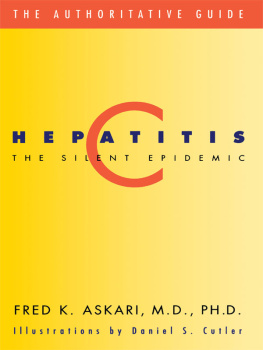Hepatitis C, The Silent Epidemic
The Authoritative Guide
FRED K. ASKARI, M.D., PH.D
Illustrations by
DANIEL S. CUTLER, C.M.I.
PERSEUS PUBLISHING
Cambridge, Massachusetts
Many of the designations used by manufacturers and sellers to distinguish their products are claimed as trademarks. Where those designations appear in this book and Perseus Publishing was aware of a trademark claim, the designations have been printed in initial capital letlers.
Copyright 1999 by Fred K. Askari
All rights reserved. No part of this publication may be reproduced. stored in a retrieval system, or transmitted, in any form or by any means, electronic, mechanical, photocopying, recording, or otherwise, without the prior written permission oi the publisher. Printed in the United States of America.
Cataloging-in-Publication Data is available from the library of Congress
ISBN 0-7382-0438-2
eBook ISBN: 9780738204383
Perseus Publishing is a member ot the Perseus Books Group.
Find us on the World Wide Web at http://www.perseuspublishing.com
Perseus Publishing books are available at special discounts for bulk purchases in the U.S. by corporations, institutions, and other organizations. For more information, please contact the Special Markets Department at the Perseus Books Group, 11 Cambridge Center. Cambridge, MA 02142, or call (617)252-5298.
Composition by Professional Composition. Inc., East Lansing, Michigan
First printing, March 2001
1 2 3 4 5 6 7 8 9 1003 02 01
To the tens of millions of people who suffer with hepatitis C infection throughout the world
Preface
B ack In the early 1930s, people started getting violently ill and dying from a new disease then known as gay-related immune deficiency syndrome, or GRID. Eventually we came to know this illness as AIDS, and scientists in France and America take credit for discovering its cause, the virus formally known as HIV. HIV, like other viruses, is a microscopic composition of protein and nucleic acid molecules. What is particularly perplexing about this virus is that the initial infection is often not noticed, and the deadly consequences of chronic infection are often not felt until years after the initial infection occurred.
As a student studying medicine at the time of onset of the HIV epidemic, I was struck by the vast array of diseases with unknown causes. One intriguing question is whether, given that HIV can infect someone and pass undetected only to manifest as disease many years later, there are other viruses that infect the body and cause injury years or decades later. Could cancer or liver disease be an endpoint of a chronic infection just like AIDS?
The answers to these questions are coming into sharper focus only recently. What is now known is that many cases of liver disease and liver cancer can be attributed to chronic viral infection. In 1989, a second virus which causes persistent infectionhepatitis C, or HCVwas identified. Hepatitis C causes one-third of all cases of chronic hepatitis leading to cirrhosis, liver failure, and liver cancer. Most of these cases were previously called cryptogenic, which means we did not know what caused them. Now medical researchers have identified the cause of most cases of cryptogenic cirrhosis as a chronic viral infection, hepatitis C, which has been infecting the human population for decades. Like HIV, hepatitis C infection generally results in a chronic persistent infection with signs of disease often showing up years or decades after the initial infection. What is striking about hepatitis C, in contrast to HIV, is that about 2% of the United States population was already infected with hepatitis C when the virus was first discovered. HIV is 4-fold less common in this country.
One of the challenges delaying the discovery of hepatitis C is that people infected with this virus come to medical attention for many different reasons. Hepatitis C is a master of disguise and intrigue, like an actor who can wear many different costumes and play a repertoire of characters. The appearance of the disease can be quite variable from person to person. The signs of hepatitis C infection that bring individuals to the attention of a physician may take many different forms. Abnormal blood tests can be discovered on routine screening. Infected individuals may have symptoms of tiredness or chronic fatigue. They may be plagued with joint aches, a rash, hives, or kidney problems. Finally, in more advanced cases, hepatitis Cinfected people may suffer from liver failure. Once the liver becomes scarred over in the patient with hepatitis C infection, liver cancer occurs at a rate of 12% per year. Liver cancer is frightening because the treatments for most cases of liver cancer are not very effective.
This virus poses an immense problem. Hepatitis C persistently infects approximately 2% of the United States population, which translates into over 4 million people. The best estimates are that of those 4 million, approximately 20%800,000 Americanswill progress to cirrhosis, liver failure, or liver cancer at some point in their lives. Hepatitis C is the leading necessitator of liver transplantation in the United States. Hepatitis C therefore poses a major public health risk. It is also a substantial cause of anxiety for those who are diagnosed, many of whom have chronic or ongoing symptoms such as fatigue and joint soreness.
Thousands of people are being told daily that they are infected with this virus. They want more answers than they can get from a simple pamphlet readily available at a physicians office or from a brief encounter with a physician. The concerns extend to other individuals such as spouses, sexual partners, coworkers, and other family members. The hepatitis C virus is such a pernicious and growing health problem that everyone needs to learn about it.
The huge pool of chronically infected people have many questions about the virus and few good answers. It is my aim to make readily available the truth about hepatitis C: how the virus was discovered, whom it infects, current treatments, emerging future treatments, and important precautions to prevent infection. Much of this information has only recently become available, and a large part of even the medical population is still poorly educated with regard to this virus. Through relating experiences of people with this dreadful infection, I hope to put a human face on this disease so that the reader may come to appreciate the impact of infection and understand its various symptoms and outcomes.
Acknowledgments
I would like to acknowledge my colleagues In the Gastroenter-ology Division at the University of Michigan as well as hepa-tologists throughout the country for many insightful discussions; my patients for teaching me so much of this dreaded disease; and the thousands of basic and clinical investigators who helped to develop our knowledge of hepatitis C and its treatments.
I am also forever indebted to Linda Greenspan Regan, executive editor at Plenum Books, for her rapid and expert assistance honing the text to be more easily read both by people infected by hepatitis C and by those interested in learning more about the disease.
Hepatitis C, The Silent Epidemic
The Authoritative Guide
1
The Illness
D r. Robert Bates was relieved to be finishing his internal medicine residency in 1989, having spent a great deal of effort learning to be a physician. He enjoyed helping people, but the grind of his day-to-day routine eventually grew tiresome. After 4 years in medical school studying facts and learning what caused some diseases, he had spent 3 years in his residency program learning more practical issues of daily patient care. He was delighted that this chapter in his training was coming to a close.







